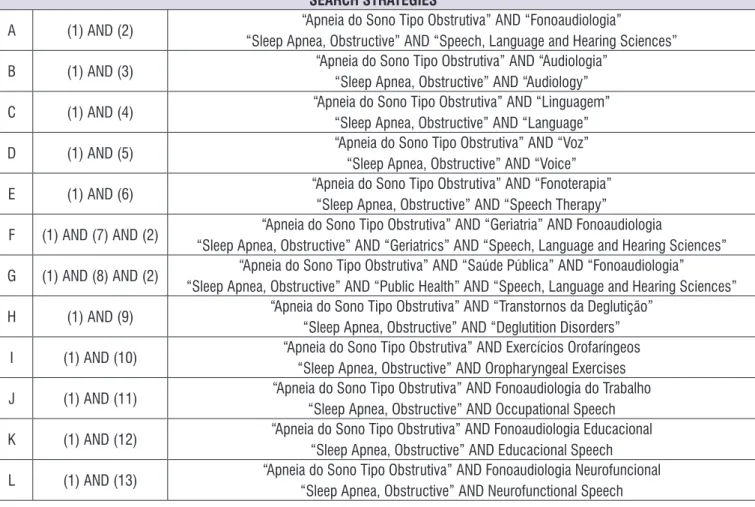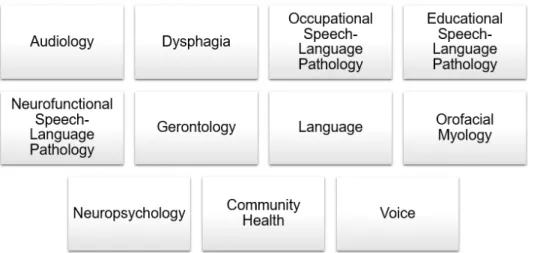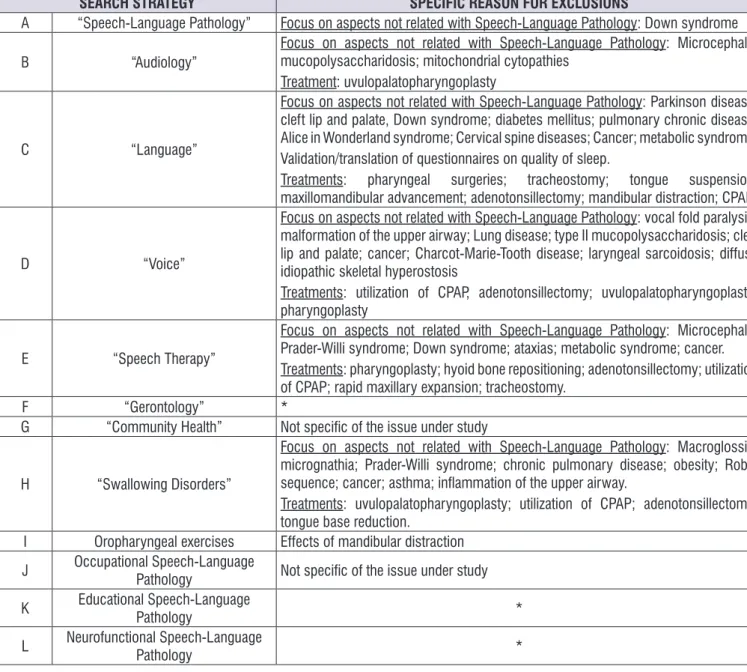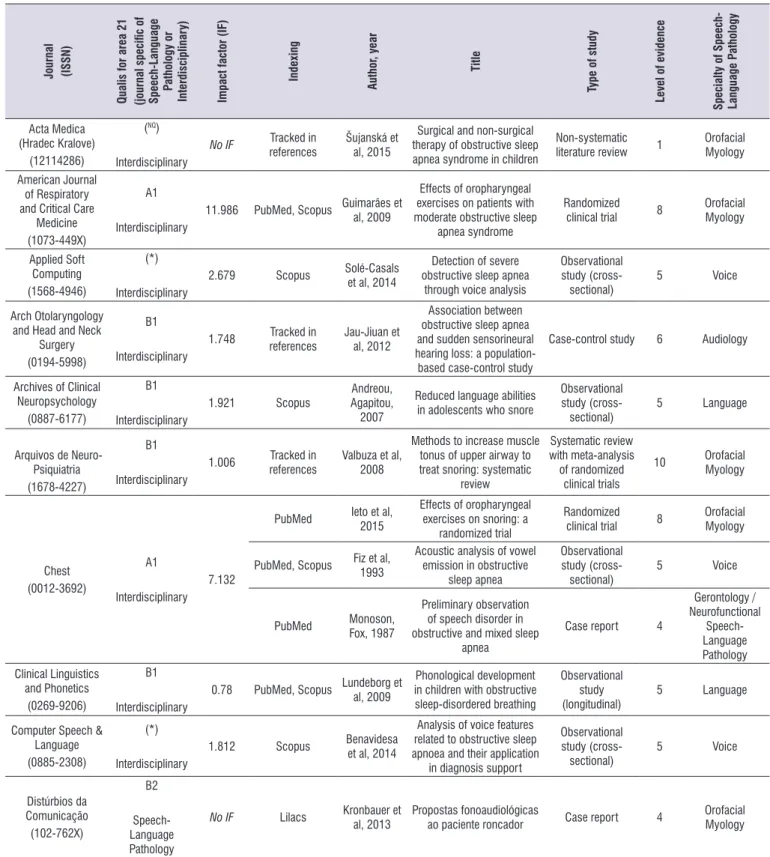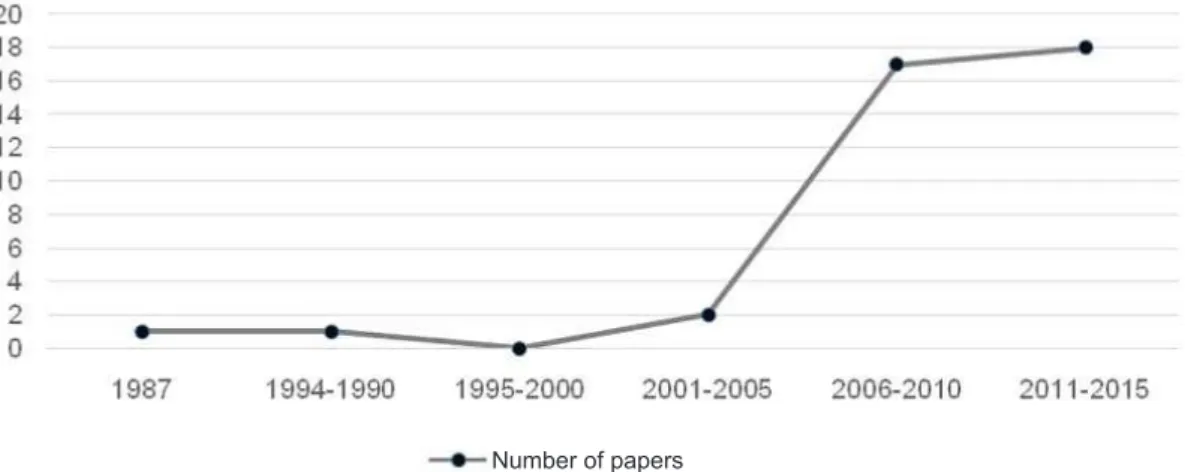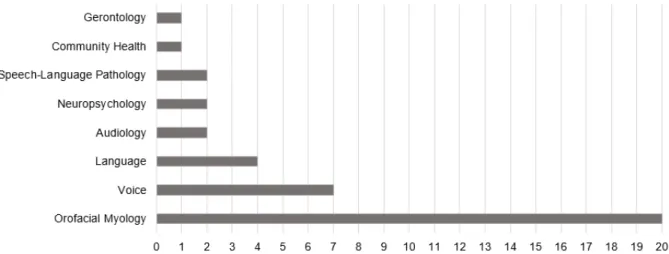(1) Departamento de Oftalmologia,
Otorrinolaringologia e Cirurgia de Cabeça e Pescoço da Faculdade de Medicina de Botucatu, Universidade Estadual Paulista “Júlio de Mesquita Filho”, FMB-UNESP, Botucatu, SP, Brasil.
(2) Departamento de Fonoaudiologia da
Faculdade de Odontologia de Bauru, Universidade de São Paulo, FOB-USP, Bauru, SP, Brasil.
Conlict of interest: non-existent
Profile of scientific production of obstructive sleep apnea in
interface of speech and language pathology
Perfil da produção científica da apneia obstrutiva do sono
na interface da fonoaudiologia
Camila de Castro Corrêa(1)
Silke Anna Theresa Weber(1)
Luciana Paula Maximino(2)
Received on: December 17, 2015 Accepted on: August 11, 2016
ABSTRACT
The purpose of this study was to investigate the scientiic production of Speech-Language Pathology and Audiology at the interface with Obstructive Sleep Apnea, considering impact factor, level of evidence and corresponding area of the Speech-Language Pathology and Audiology. A literature search was performed in databases Lilacs, PubMed and Scopus, through the intersection of keywords and speciic free terms of Speech-Language Pathology and Audiology and “Sleep Apnea, Obstructive”. For the article would be included in this study, needed to approach as the main axis the Speech-Language Pathologist acting in patients with Obstructive Sleep Apnea. Were held a consultation on the WebQualis CAPES, investigating speciic journals of Speech-Language Pathology and Audiology of Area 21 and their respective Qualis. Selected articles were analyzed for impact factor, level of evidence and area of the corresponding Speech-Language Pathology and Audiology. Were located 983 articles, being selected 39, originated mainly from Scopus. The prevalent was the Qualis B1, with an average impact factor of 3,49; higher number of publications of 2006, level of evidence 5 and the Speech-Language Pathology and Audiology prevalent area was the Orofacial Myology. The analysis of the scientiic production of Speech-Language Pathology and Audiology was performed at the interface with Obstructive Sleep Apnea, verifying that the Orofacial Myology and the evidence level 5 predominated in this context.
Keywords: Speech, Language and Hearing Sciences; Sleep Apnea, Obstructive; Impact Factor; Interdisciplinary Research; Evidence-Based Practice
RESUMO
Este estudo teve por objetivo averiguar a produção cientíica da Fonoaudiologia na interface com Apneia
Obstrutiva do Sono, considerando fator de impacto, nível de evidência e área da Fonoaudiologia corres
1210 | Corrêa CC, Weber SAT, Maximino LP
INTRODUCTION
The consequences of obstructive sleep apnea
(OSA) inluence the general health of the individual,
e.g. in cardiovascular disorders1,2 and cerebrovascular
accident3, besides the direct implications on
communi-cation processes and disorders, especially in the ields
of work of Speech-Language Pathology.
For example, it may be associated with hearing aspects, such as reduced amplitude of P3004,
sensori-neural hearing loss5 and auditory processing disorders
in children6 (AUDIOLOGY); signs of swallowing
disorder7,8 (DYSPHAGIA); association with work
accidents9 (OCCUPATIONAL SPEECH-LANGUAGE
PATHOLOGY) and learning and memory alterations10
(EDUCATIONAL SPEECH-LANGUAGE PATHOLOGY). Individuals with OSA present higher risk of
cerebro-vascular accident3 (NEUROFUNCTIONAL
SPEECH-LANGUAGE PATHOLOGY), and OSA is more frequent with aging11 (GERONTOLOGY). It is also associated
with changes in performance in language levels12,13
(LANGUAGE), alterations in oropharyngeal muscle tone14,15 (OROFACIAL MYOLOGY), neurocognitive
disorders in children (NEUROPSYCHOLOGY)16 and
differences in acoustic voice parameters17,18 (VOICE).
Considering all these aspects, Speech-Language Pathology should also be involved in training programs for behavioral changes, favoring a better quality of
sleep19 (COMMUNITY HEALTH).
These indings of scientiic publications justify the
action of Speech-Language Pathology in OSA, as well as the need of further investigations to elucidate the
scope of such publications in scientiic journals.
This production of knowledge is fundamental for the advancement of science and an important opportunity
to diffuse and enhance the scientiic indings20.
This, this study analyzed the scientiic production
of Speech-Language Pathology in its interface with obstructive sleep apnea, considering the impact factor, level of evidence and corresponding specialty within Speech-Language Pathology.
METHODS
A literature search was performed on the databases Lilacs, PubMed and Scopus, crossing the DeCS/MeSH keywords: “Sleep Apnea, Obstructive” (1), “Speech, Language and Hearing Sciences” (2), “Audiology” (3), “Language” (4), “Voice” (5), “Speech Therapy” (6), “Geriatrics” (7), “Public Health” (8) and “Deglutition
of Speech-Language Pathology, the following free terms were also employed: Oropharyngeal exercises (10), Occupational Speech-Language Pathology (11), Educational Speech-Language Pathology (12), Neurofunctional Speech-Language Pathology (13). All keywords and free terms were used both in Portuguese and English. This generated 12 search strategies, as described in Figure 1.
Further three searches were performed using the keywords (1) AND mastication, AND speech and AND swallowing, yet no further papers related to the issue were found, thus these were not considered.
Papers were included in the study if their main focus was the role of Speech-Language Pathology on the clinical presentation of OSA.
The following exclusion criteria were considered:
studies speciic of other procedures (surgery, dental
treatment, drug therapy, CPAP); studies whose main focus was the development/evaluation of question-naires on quality of life; investigations addressing other genetic syndromes (Down, craniosynostosis and velocardiofacial syndromes); editorials and letter to the editor. The search was conducted using the VPN system (Virtual Private Network), and papers whose full texts were not available were also excluded.
The references of included papers were also
analyzed, so that any study not identiied on the
databases could also be analyzed and added in the study, in case it met the inclusion criteria.
The Qualis classiication of journals was checked by assessing the full list of journals on the website
WebQualis of the Coordination for the Improvement of Higher Education Personnel (CAPES), which consisted of 4,524 pages21. Searching only for journals
of the “PHYSICAL EDUCATION” area and considering
speciic journals of Speech-Language Pathology, the journals were considered if their title included one of
the following words, either in Portuguese, English or Spanish:
• Speech-Language Pathology
• Communication/Communicate/Communications • Language
• Disluency • Speech • Aphasia
• Noise • Tinnitus • Voice
In case the journal titles were acronyms, their
websites were searched to investigate if the publica-tions actually focused on Speech-Language Pathology.
Thus, Figure 2 presents the list with ISSN, journal name and Qualis CAPES, of journals considered speciic of
Speech-Language Pathology (the list was accessed on July 2015).
The impact factor was also analyzed, which is considered an instrument to evaluate the quality
of journals22. The impact factor was searched on
September 2015 on the website http://www.citefactor.
org/, searching all journals of included references.
The papers were initially selected by reading the titles and abstracts. Following, the selected papers
were analyzed as to the journal, year of publication,
title, specialty within Speech-Language Pathology, type of study, and level of evidence, in which the lowest was scored as 1 and the highest as 10, according to the study design23.
Each paper was also classiied in one or more
specialties of Speech-Language Pathology addressed, among the 11 specialties, as described in Figure 324.
Data were analyzed in characterizer mode, using descriptive and inductive statistics and Spearman corre-lation (p<0.05), analyzing the recorre-lationship between: • Qualis and year of publication
• Qualis and level of evidence Year and level of evidence SEARCH STRATEGIES
A (1) AND (2) “Apneia do Sono Tipo Obstrutiva” AND “Fonoaudiologia”
“Sleep Apnea, Obstructive” AND “Speech, Language and Hearing Sciences”
B (1) AND (3) “Apneia do Sono Tipo Obstrutiva” AND “Audiologia”
“Sleep Apnea, Obstructive” AND “Audiology”
C (1) AND (4) “Apneia do Sono Tipo Obstrutiva” AND “Linguagem”
“Sleep Apnea, Obstructive” AND “Language”
D (1) AND (5) “Apneia do Sono Tipo Obstrutiva” AND “Voz”
“Sleep Apnea, Obstructive” AND “Voice”
E (1) AND (6) “Apneia do Sono Tipo Obstrutiva” AND “Fonoterapia”
“Sleep Apnea, Obstructive” AND “Speech Therapy”
F (1) AND (7) AND (2) “Apneia do Sono Tipo Obstrutiva” AND “Geriatria” AND Fonoaudiologia
“Sleep Apnea, Obstructive” AND “Geriatrics” AND “Speech, Language and Hearing Sciences”
G (1) AND (8) AND (2) “Apneia do Sono Tipo Obstrutiva” AND “Saúde Pública” AND “Fonoaudiologia”
“Sleep Apnea, Obstructive” AND “Public Health” AND “Speech, Language and Hearing Sciences” H (1) AND (9) “Apneia do Sono Tipo Obstrutiva” AND “Transtornos da Deglutição”
“Sleep Apnea, Obstructive” AND “Deglutition Disorders”
I (1) AND (10) “Apneia do Sono Tipo Obstrutiva” AND Exercícios Orofaríngeos“Sleep Apnea, Obstructive” AND Oropharyngeal Exercises
J (1) AND (11) “Apneia do Sono Tipo Obstrutiva” AND Fonoaudiologia do Trabalho “Sleep Apnea, Obstructive” AND Occupational Speech K (1) AND (12) “Apneia do Sono Tipo Obstrutiva” AND Fonoaudiologia Educacional
“Sleep Apnea, Obstructive” AND Educacional Speech
L (1) AND (13) “Apneia do Sono Tipo Obstrutiva” AND Fonoaudiologia Neurofuncional“Sleep Apnea, Obstructive” AND Neurofunctional Speech
Legend: Terms between “ ”: keywords listed in DeCS/MeSH
ISSN Journal Qualis CAPES
01 1420-3030 Audiology & Neuro-Otology (Print) A1
02 0093-934X Brain and Language A1
03 0196-0202 Ear and Hearing (Print) A1
04 0378-5955 Hearing Research A1
05 1499-2027 International Journal of Audiology A1
06 1368-2822 International Journal of Language and Communication Disorders (Print) A1
07 0094-730X Journal of Fluency Disorders A1
08 1092-4388 Journal of Speech, Language, and Hearing Research (Print) A1
09 0002-726X American Annals of the Deaf (Washington, D.C. 1886. Print) A2
10 0268-7038 Aphasiology (London) A2
11 0179-051X Dysphagia (New York. Print) A2
12 1754-9507 International Journal of Speech-Language Pathology (Print) A2
13 0021-9924 Journal of Communication Disorders A2
14 0892-1997 Journal of Voice A2
15 1463-1741 Noise & Health A2
16 0104-5687 Pró-Fono (Impresso) A2
17 2179-6491 Sociedade Brasileira de Fonoaudiologia. Jornal A2
18 1651-386X Audiological Medicine B1
19 1516-1846 Revista CEFAC (Impresso) B1
20 1516-8034 Revista da Sociedade Brasileira de Fonoaudiologia (Impresso) B1
21 1982-0232 Revista da Sociedade Brasileira de Fonoaudiologia (On-line) B1
22 0214-4603 Revista de Logopedia, Foniatría y Audiología (Ed. Impresa) B1
23 0745-7472 The Hearing Journal B1
24 0735-0120 The International Journal of Orofacial Myology B1
25 0946-5448 The International Tinnitus Journal B1
26 0102-762X Distúrbios da Comunicação B2
27 2176-2724 Distúrbios da Comunicação B2
28 1535-2609 Audiology Today B3
29 1074-5734 The Hearing Review B3
30 1657-723X Audiologia Hoy B4
31 1313-1400 Bulgarian Journal of Communication Disorders B4
32 1647-3485 Cadernos de Comunicação e Linguagem B4
33 1668-9402 Fonoaudiológica (Buenos Aires) B4
34 1735-045X Iranian Audiology B4
35 2236-9740 Journal of Speech Sciences B4
36 1415-1928 Linguagem & Ensino (UCPel. Impresso) B4
37 1696-1544 Logopédia Revista del Col-legi de Logopedes de Catalunya B4
38 1370-706X Logopedie: informatiemedium van de Vlaamse Vereniging voor Logopedisten B4
39 1679-3048 Revista da Fonoaudiologia (CRFa/SP) B4
40 0718-4891 Revista de Fonoaudiología - Universidad de Valparaíso B4
41 1807-9040 Revista Fonoaudiologia Brasil (Online) B4
42 0104-8481 Comunicações (UNIMEP) B5
43 1807-3115 Anais (Congresso Brasileiro de Fonoaudiologia) C
44 1021-7762 Folia Phoniatrica et Logopaedica C
45 1421-9972 Folia Phoniatrica et Logopaedica (Online) C
46 1806-6151 PET Informa (FOB / USP) C
47 2179-0841 Revista da Sociedade Brasileira de Fonoaudiologia - Suplemento C
Figure 4 presents the speciic relationship of main
focus of studies that were excluded, according to the exclusion criteria.
Table 2 displays the analysis of papers selected for the study. It also presents the scoring of the level of evidence, in which the lowest was scored as 1 and the highest as 10, according to the study design23.
LITERATURE REVIEW
By the strategies adopted to search the databases, 10 papers were found in Lilacs, 598 in PubMed and 375 in Scopus. Table 1 describes this result, highlighting that repeated papers found in different databases are included, as well as repetition of strategies in different searches.
Figure 3. Fields of Speech-Language Pathology assigned for selected papers
Table 1. Number of papers found and selected in databases Lilacs, PubMed and Scopus, for each search strategy
Strategy Lilacs
(total n)
Lilacs (selected n)
PubMed (total n)
PubMed (selected n)
Scopus (total n)
Scopus (selected n)
A 4 3 6 0 2 2
B 0 0 5 0 7 2
C 0 0 185 3 153 6
D 0 0 64 3 85 7
E 3 3 43 3 57 4
F 0 0 0 0 1 0
G 0 0 18 2 0 0
H 0 0 264 2 64 4
I 3 2 7 5 5 3
J 0 0 4 0 1 0
K 0 0 1 0 0 0
SEARCH STRATEGY SPECIFIC REASON FOR EXCLUSIONS
A “Speech-Language Pathology” Focus on aspects not related with Speech-Language Pathology: Down syndrome
B “Audiology”
Focus on aspects not related with Speech-Language Pathology: Microcephaly; mucopolysaccharidosis; mitochondrial cytopathies
Treatment: uvulopalatopharyngoplasty
C “Language”
Focus on aspects not related with Speech-Language Pathology: Parkinson disease; cleft lip and palate, Down syndrome; diabetes mellitus; pulmonary chronic disease; Alice in Wonderland syndrome; Cervical spine diseases; Cancer; metabolic syndrome. Validation/translation of questionnaires on quality of sleep.
Treatments: pharyngeal surgeries; tracheostomy; tongue suspension;
maxillomandibular advancement; adenotonsillectomy; mandibular distraction; CPAP.
D “Voice”
Focus on aspects not related with Speech-Language Pathology: vocal fold paralysis; malformation of the upper airway; Lung disease; type II mucopolysaccharidosis; cleft lip and palate; cancer; Charcot-Marie-Tooth disease; laryngeal sarcoidosis; diffuse idiopathic skeletal hyperostosis
Treatments: utilization of CPAP, adenotonsillectomy; uvulopalatopharyngoplasty; pharyngoplasty
E “Speech Therapy”
Focus on aspects not related with Speech-Language Pathology: Microcephaly; Prader-Willi syndrome; Down syndrome; ataxias; metabolic syndrome; cancer.
Treatments: pharyngoplasty; hyoid bone repositioning; adenotonsillectomy; utilization
of CPAP; rapid maxillary expansion; tracheostomy.
F “Gerontology” *
G “Community Health” Not speciic of the issue under study
H “Swallowing Disorders”
Focus on aspects not related with Speech-Language Pathology: Macroglossia; micrognathia; Prader-Willi syndrome; chronic pulmonary disease; obesity; Robin sequence; cancer; asthma; inlammation of the upper airway.
Treatments: uvulopalatopharyngoplasty; utilization of CPAP; adenotonsillectomy; tongue base reduction.
I Oropharyngeal exercises Effects of mandibular distraction J Occupational Speech-Language
Pathology Not speciic of the issue under study K Educational Speech-Language
Pathology *
L Neurofunctional Speech-Language Pathology *
Legend: (*): no papers were found
Table 2. Information on the journal, author, title year, type of study, level of evidence and specialty of Speech-Language Pathology of
papers considered in the present study
Jou rn a l (I S S N ) Q u a li s f or a re a 21 (jou rn al sp ec iic of S p ee ch -L a n g u a g e P a th ol og y or In te rd isc ip li n a ry ) Imp a ct f a ctor ( IF ) In d exi n g A u th or , y ea r T itl e Ty p e of stu d y Le ve l of e vi d en ce S p ec ia lty of S p ee ch -La n g u a g e P a th ol og y Acta Medica (Hradec Kralove) (12114286)
(NQ)
Interdisciplinary
No IF Tracked in references
Šujanská et al, 2015
Surgical and non-surgical therapy of obstructive sleep apnea syndrome in children
Non-systematic literature review 1
Orofacial Myology
American Journal of Respiratory and Critical Care
Medicine (1073-449X)
A1
Interdisciplinary 11.986
PubMed, Scopus Guimarães et al, 2009
Effects of oropharyngeal exercises on patients with moderate obstructive sleep
apnea syndrome
Randomized clinical trial 8
Orofacial Myology Applied Soft Computing (1568-4946) (*) Interdisciplinary 2.679
Scopus Solé-Casals et al, 2014
Detection of severe obstructive sleep apnea
through voice analysis
Observational study
(cross-sectional)
5 Voice
Arch Otolaryngology and Head and Neck
Surgery (0194-5998) B1 Interdisciplinary 1.748 Tracked in references Jau-Jiuan et al, 2012 Association between obstructive sleep apnea and sudden sensorineural hearing loss: a population-based case-control study
Case-control study 6 Audiology
Archives of Clinical Neuropsychology (0887-6177) B1 Interdisciplinary 1.921 Scopus Andreou, Agapitou, 2007
Reduced language abilities in adolescents who snore
Observational study
(cross-sectional) 5 Language
Arquivos de Neuro-Psiquiatria (1678-4227)
B1
Interdisciplinary
1.006 referencesTracked in Valbuza et al, 2008
Methods to increase muscle tonus of upper airway to treat snoring: systematic
review
Systematic review with meta-analysis of randomized
clinical trials
10 Orofacial Myology
Chest (0012-3692)
A1
Interdisciplinary 7.132
PubMed Ieto et al, 2015
Effects of oropharyngeal exercises on snoring: a
randomized trial
Randomized clinical trial 8
Orofacial Myology
PubMed, Scopus Fiz et al, 1993
Acoustic analysis of vowel emission in obstructive
sleep apnea
Observational study
(cross-sectional)
5 Voice
PubMed Monoson, Fox, 1987
Preliminary observation of speech disorder in obstructive and mixed sleep
apnea
Case report 4
Gerontology / Neurofunctional Speech-Language Pathology Clinical Linguistics and Phonetics (0269-9206) B1 Interdisciplinary 0.78
PubMed, Scopus Lundeborg et al, 2009
Phonological development in children with obstructive sleep-disordered breathing
Observational study (longitudinal)
5 Language
Computer Speech & Language (0885-2308)
(*)
Interdisciplinary 1.812
Scopus Benavidesa et al, 2014
Analysis of voice features related to obstructive sleep apnoea and their application
in diagnosis support
Observational study (cross-sectional) 5 Voice Distúrbios da Comunicação (102-762X) B2 Speech-Language Pathology
No IF Lilacs Kronbauer et
al, 2013 Propostas fonoaudiológicas ao paciente roncador Case report 4
Jou rn a l (I S S N ) Q u a li s f or a re a 21 (jou rn al sp ec iic of S p ee ch -L a n g u a g e P a th ol og y or In te rd isc ip li n a ry ) Imp a ct f a ctor ( IF ) In d exi n g A u th or , y ea r T itl e Ty p e of stu d y Le ve l of e vi d en ce S p ec ia lty of S p ee ch -La n g u a g e P a th ol og y
Eurasip Journal on Advances in Signal
Processing (1687-6180)
(*)
Interdisciplinary
0.808 Scopus Pozo et al, 2009
Assessment of Severe Apnoea through Voice Analysis, Automatic Speech, and Speaker Recognition Techniques Observational study (cross-sectional) 5 Voice International Archives of Otorhinolaryngology (1809-4856) B1 Interdisciplinary
No IF PubMed, Scopus Corrêa et al, 2015 Obstructive Sleep Apnea Health Promotion in Syndrome
Non-systematic literature review 1
Community Health
Lilacs Pitta et al, 2007
Oral myofunctional therapy applied on two cases of severe obstructive sleep
apnea
Case report 4 Orofacial
Myology
International Journal of Pediatric Otorhinolaryngology
(0165-5876)
B1
Interdisciplinary 1.319
Scopus Kurnatowski et al, 2006
Neurocognitive abilities in children with adenotonsillar
hypertrophy
Observational study
(cross-sectional)
5 Neuropsychology
Journal of Clinical and Experimental Neuropsychology
(1744-411X)
(*)
Interdisciplinary 2.158
PubMed Salorio et al, 2002
Learning, memory, and executive control in individuals with obstructive
sleep apnea syndrome
Observational study
(cross-sectional)
5 Language
Journal of Voice (0892-1997)
A2
Speech-Language Pathology
0.944 PubMed, Scopus
Montero Benavides et
al, 2015
Formant Frequencies and Bandwidths in Relation to Clinical Variables in an Obstructive Sleep Apnea
Population Observational study (cross-sectional) 5 Voice Laryngoscope (0023-852X) A2 Interdisciplinary
2.032 Scopus Hara et al, 2006
Acoustic analysis of snoring sounds by a multidimensional voice program Observational study (cross-sectional) 5 Voice Neurotherapeutics (1933-7213) (*) Interdisciplinary 3.883
PubMed Brass, 2012De Dios,
New and unconventional treatments for obstructive
sleep apnea
Non-systematic literature review 1
Orofacial Myology
Pan Arab Journal of Neurosurgery (1319-6995)
(NQ)
Interdisciplinary
No IF Tracked in references
Baz et al, 2012
The role of oral myofunctional therapy in managing patients with mild
to moderate obstructive sleep apnea
Case series 4 Orofacial
Myology
Pediatrics (0031-4005)
A1
Interdisciplinary 5.297
Scopus O’Brien et al, 2004
Neurobehavioral implications of habitual
snoring in children
Observational study (cross-sectional) 5 Neuropsychology Pediatric Neurology (0887-8994) (*) Interdisciplinary 1.504
PubMed, Scopus Caspari et al, 2008
Obstructive Sleep Apnea, Seizures, and Childhood
Apraxia of Speech
Observational study (longitudinal)
5 / Orofacial Language Myology
Rehabilitacion (0048-7120)
B3
Interdisciplinary 0.946 Lilacs, Scopus Rangel-León et al, 2015
Rehabilitación de músculos orofaríngeos con ejercicios
y electroterapia para el síndrome de apnea-hipoapnea obstructiva del
sueño
Case series 4 Orofacial
Myology
Respirology
(1323-7799) Interdisciplinary 3.495 PubMed Bucks, 2013
Neurocognitive function in obstructive sleep apnoea: a
meta-review
Systematic review with meta-analysis 9
Neurofunctional Speech-Language Pathology
Revista Brasileira de Otorrinolaringologia
(0034-7299)
A2
Interdisciplinary
No IF Scopus Ziliotto et al, 2006
Avaliação do processamento auditivo em
Jou rn a l (I S S N ) Q u a li s f or a re a 21 (jou rn al sp ec iic of S p ee ch -L a n g u a g e P a th ol og y or In te rd isc ip li n a ry ) Imp a ct f a ctor ( IF ) In d exi n g A u th or , y ea r T itl e Ty p e of stu d y Le ve l of e vi d en ce S p ec ia lty of S p ee ch -La n g u a g e P a th ol og y Revista CEFAC (1982-0216) B1 Speech-Language Pathology No IF
Lilacs Matsumura et al, 2014.
A percepção do acompanhante e do indivíduo com ronco/saos
antes e após fonoterapia
Observational study (longitudinal)
5 Orofacial Myology
Lilacs Soares et al, 2010 Fonoaudiologia X ronco/apneia do sono Non-systematic literature review 1 Orofacial Myology
Lilacs Rosa et al, 2010 Fonoaudiologia e apneia do sono: uma revisão Non-systematic literature review 1 Orofacial Myology
Lilacs Landa et al, 2009
Síndrome da apneia e hipoapneia obstrutiva do sono e o enfoque fonoaudiológico: revisão de
literatura
Non-systematic literature review 1
Orofacial Myology
Tracked in references
Silva et al, 2007
Atuação fonoaudiológica na síndrome da apnéia e hipopnéia obstrutiva do
sono: relato de caso
Case report 4 Orofacial
Myology
Revista medico-chirurgicala a Societatii de Medici si Naturalisti din Iasi
(0300-8738)
(NQ)
Interdisciplinary
No IF PubMed, Scopus Cernomaz et al, 2010 Obstructive sleep apnea patients voice analysis
Observational study (cross-sectional) 5 Voice Sleep (0161-8105) A1 Interdisciplinary 5.062 Tracked in references Camacho et al, 2015 Myofunctional therapy to treat obstructive sleep apnea: a systematic review
and meta-analysis
Systematic review with meta-analysis 9
Orofacial Myology
PubMed Aaronson et al, 2014
Obstructive Sleep Apnea is Related to Impaired Cognitive and Functional
Status After Stroke
Case-control 6
Neurofunctional Speech-Language Pathology
Sleep & Breathing (1520-9512)
B1
Interdisciplinary 2.869
PubMed Villa et al, 2015
Oropharyngeal exercises to reduce symptoms of OSA
after AT Observational study (longitudinal) 5 Orofacial Myology Tracked in references
Valbuza et al, 2010
Methods for increasing upper airway muscle tonus in treating obstructive sleep apnea: systematic review
Systematic review with meta-analysis of randomized
clinical trials
10 Orofacial Myology
Sleep Medicine (1389-9457)
A2
Interdisciplinary
3.1 PubMed, Scopus Diaferia et al, 2013
Effect of speech therapy as adjunct treatment to continuous positive airway
pressure on the quality of life of patients with obstructive sleep apnea
Randomized clinical trial 4
Orofacial Myology
Sleep Medicine Clinics (1556-407X)
(NQ)
Interdisciplinary
No IF Tracked in references
Cooper, 2010
Orofacial myology and myofunctional therapy for
sleep related breathing disorders
Non-systematic literature review 1
Orofacial Myology Sleep Science (1984-0659) B4 Interdisciplinary
No IF Scopus Diaféria et al, 2011
Phonoaudiological assessment of patients with
obstructive sleep apnea
Observational study
(cross-sectional)
5 Orofacial Myology
The descriptive statistical analysis revealed that the Qualis of publications was A1 in 7 papers (17.9%), A2 in 4 (10.3%), B1 in 14 papers (35.9%), 1 paper B2, 1 B3, 1 B4 (2.6%). The remaining 11 papers (28.1%) were
published in journals not scored in the Qualis for area
21 of CAPES.
Considering the 30 journals with publications
included in this study, 9 did not have impact factor, and
the other 21 journals had impact factor with mean 3.49,
median 2.42, standard deviation 2.82, maximum 11.99 and minimum 0.78.
Concerning the indexing of papers, 7 were found both on PubMed and Scopus (17.9%), 9 in Scopus (23.1%), 8 only in PubMed (20.5%), 6 in Lilacs (15.4%)
e 1 was found both in Lilacs and Scopus (2.6%); further 8 (20.5%) were found by consulting the references of included papers.
The distribution of publication years was diffuse, with 1 paper published in years 1987, 1993, 2002 and 2004; 3 publications in 2006 and 2007; 2 in 2008; 4 in 2009; 5 in 2010;1 in 2011; 3 in 2012 and 2013; 4 in 2014 and 7 in 2015. Analysis in 5-year periods revealed the distribution presented in Figure 5.
The levels of evidence 10, 9, 8 and 6 presented 2 papers each (5.2%); level 5 was assigned to 17 papers (43.6%), 4 for 7 papers (17.8%), and level 1 for 7 papers (17.8%), as described in Figure 6.
Number of papers
Figure 5. Analysis of number of papers according to year of publication, in 5-year periods
Among the 11 specialties of Speech-Language
Pathology, 20 papers were speciic of Orofacial Myology, 7 of Voice, 3 Language, and the ields of
Audiology, Neuropsychology and Neurofunctional
Speech-Language Pathology presented 2 publications, while Community Health, Gerontology/Neurofunctional Speech-Language Pathology and Language/Orofacial Myology had 1 publication each (Figure 7).
Figure 7. Number of papers according to specialty of Speech-Language Pathology
Characterization of publications of a certain ield
widens the knowledge on the advancement of science, allowing more effective establishment of new pathways for scientists. Especially for OSA and its interface with
Speech-Language Pathology, this process is justiied
to strengthen the advanced action of this area in the evaluation, treatment, prevention and health promotion in clinical situations with OSA.
During the search, more papers were found in
among the references of included papers. Concerning the PubMed and Scopus, it should be highlighted that the former presents 25 millions of biomedical citations
on the Medline, online journals and books25 while the
second is considered the largest database of abstracts and literature citations, besides including conference proceedings26.
Despite the high number of papers found (983), the percentage of exclusion was also high (96.03%) and may be explained by the diverse descriptors and
free terms used in an attempt to address all ields of
Speech-Language Pathology.
There was greater number of papers in score B1 of Qualis, followed by papers without Qualis score in the area 21 of CAPES. A previous study analyzing the level of publications of a post graduation program in Speech-Language Pathology revealed the same predominance of Qualis B127.
Among the journals included, 77% presented
impact factor, different from a previous study in Speech-Language Pathology in which only 23% of
journals had impact factor, besides presenting lower
minimum and maximum values compared to the
. The inding that only 5% of papers
Table 3. Spearman correlation of the variables Qualis, year of publication and level of evidence
CORRELATIONS p value
Qualis X year of publication 0.30 Qualis X level of evidence 0.06 Year of publication X level of evidence 0.98 Legend: p<0.05 – statistically signiicant value
The Spearman correlation did not reveal signiicant
4. Martins CH, Castro Júnior Nd, Costa Filho OA, Souza Neto OM. Obstructive Sleep Apnea and P300 Evoked Auditory Potential. Braz J Otorhinolaryngol. 2011;77(6):700-5.
5. Sheu JJ, Wu CS, Lin HC.Association between obstructive sleep apnea and sudden sensorineural hearing loss: a population-based case-control study. Arch Otolaryngol Head Neck Surg. 2012;138(1):55-9.
6. Ziliotto KN, Santos MFC, Monteiro VG, Pradella-Hallinan M, Moreira GA, Pereira LD et al. Avaliação do processamento auditivo em crianças com síndrome da apnéia/hipopnéia obstrutiva do sono. Rev Bras Otorrinolaringol. 2006;72(3):321-7.
7. Schindler A, Mozzanica F, Sonzini G, Plebani D, Urbani E, Pecis M, Montano N.Oropharyngeal Dysphagia in patients with obstructive sleep apnea syndrome. Dysphagia. 2014;29(1):44-51.
8. Valbuza JS, Oliveira MM, Zancanella E, Conti CF, Prado LB, Carvalho LB et al. Swallowing dysfunction related to obstructive sleep apnea:
a nasal ibroscopy pilot study. Sleep Breath.
2011;15(2):209-13.
9. Santos Neto LC, Miranda GA, Cunha LLG, Canto BES, Strufaldi VP, Tetti MF et al. Consequências individuais e socioeconômicas da síndrome da apneia obstrutiva do sono. Arq Bras Ciênc Saúde. 2013;38(1):33-9.
10. Uema SFH, Pignatari SSN, Fujita RR, Moreira GA,
Pradella-Hallinan M, Weckx L et al. Avaliação da função cognitiva da aprendizagem em crianças com distúrbios obstrutivos do sono. Rev Bras Otorrinolaringol. 2007;73(3):315-20.
11. Ayalon L, Ancoli-Israel S, Drummond SPA.
Obstructive Sleep Apnea and Age A Double Insult to Brain Function? Am J Respir Crit Care Med. 2010;182(3): 413-9.
12. Kurnatowski P, Putyński L, Lapienis M,
Kowalska B. Neurocognitive abilities in children with adenotonsillar hypertrophy. Int J Pediatr Otorhinolaryngol. 2006;70(3):419-24.
13. Andreou G, Agapitou P. Reduced language abilities in adolescents who snore. ArchClin Neuropsychol. 2007;22(2):225-9.
14. Guimarães KC, Drager LF, Genta PR, Marcondes BF, Lorenzi-Filho G. Effects of Oropharyngeal Exercises on Patients with Moderate Obstructive Sleep Apnea Syndrome. Am J Respir Crit Care factor is calculated according to the number of citations
of papers published by a certain journal, evidencing low citation of papers published in national journals of
Speech-Language Pathology28.
There was greater volume of publications in Speech-Language Pathology about OSA after year 2006 and greater concentration of papers in level of evidence 5, corresponding to observational study design. No studies were found about this aspect, yet this data agrees with a previous study about the level of evidence of publications in Dentistry29.
Finally, concerning the ield of Speech-Language
Pathology, there was predominance of Orofacial Myology, which differs from the results of publications of Speech-Language Pathology in general, which
identiied Language as the irst area of publication,
followed by Audiology30.
The importance of this study is the characterization of the advancement of Speech-Language science within the scope of OSA, broadening this diffusion and
guiding the onset of new investigations in this ield.
CONCLUSION
The scientiic production of Speech-Language
Pathology was analyzed in its interface with obstructive sleep apnea, evidencing the predominance of Orofacial Myology as the specialty of publication, with higher frequency of level of evidence 5, corresponding to cross-sectional observational study.
REFERENCES
1. Carpio C, Alvarez-Sala R, García-Río F. Epidemiological and pathogenic relationship between sleep apnea and ischemic heart disease. Pulm Med. Pulmonary Medicine vol. 2013, Article ID 405827, 8 pages, 2013. doi:10.1155/2013/405827 2. Won CH, Chun HJ, Chandra SM, Sarinas PS,
Chitkara RK, Heidenreich PA. Severe obstructive sleep apnea increases mortality in patients with
ischemic heart disease and myocardial injury.
Sleep Breath. 2013;17(1):85-91.
29. Cavalcanti YW, Freires IA, Carreiro Júnior E, Gonçalves DT, Morais FR, Lira Júnior R et al. Determinação do Nível de Evidência
Cientíica de Artigos sobre Prótese Total Fixa
Implanto-Suportada. Rev Bras Ciênc Saúde. 2011;14(4):45-50.
30. Hernández-Jaramillo J, Cruz-Velandia I,
Torres-Narváez M. Investigación clínica en fonoaudiología: análisis de la literatura cientíica 2005-2009. Rev
Fac Med. 2010;58(3):204-13. 15. Steele CM. On the plausibility of upper airway
remodeling as an outcome of orofacial exercise.Am J Respir Crit Care Med. 2009;179(10):858-9.
16. Hilario SM, Silva EVCM, Chiloff CLM, Bertoz APM, Micheletti KR, Cuoghi OA et al. Distúrbios
neuropsicológicos e Síndrome da Apneia do Sono
em crianças. Arch Health Invest. 2014;3(3):65-75. 17. Benavidesa AM, Pozo RF, Toledano TD, Murillo
JLB, Gonzalo EL, Gómez LH. Analysis of voice
features related to obstructive sleep apnoea and their application in diagnosis support. Comput Speech Lang. 2014;28(2):434-52.
18. Solé-Casals J, Munteanu C, Martín OC, Barbé F, Queipo C, Amilibia J et al. Detection of severe obstructive sleep apnea through voice analysis. Appl Soft Comput. 2014;23:346-54.
19. Moseley L, Gradisar M. Evaluation of a school-based intervention for adolescent sleep problems. Sleep. 2009;32(3):334-41.
20. Oliveira Filho RSd, Hochman B, Nahas FX,
Ferreira LM. Fomento à publicação cientíica e proteção do conhecimento cientíico. Acta Cir Bras.
2005;20(supl.2):35-9.
21. Qualis CAPES. Disponível em: http://qualis.capes. gov.br/. Acesso em: 10 mai 2015
22. Quindós G. Confundiendo al confuso: relexiones
sobre el factor de impacto, el índice H(irsch),
el valor Q y otros cofactores que inluyen en la
felicidad del investigador. Rev Iberoam Micol. 2009;26(2):97-102.
23. Kyzas PA. Evidence-Based Oral and Maxillofacial Surgery. J Oral Maxillofac Surg. 2008;66(3):973-86. 24. Conselho Federal de Fonoaudiologia. Especialista
por área. Disponível em: http://www.fonoaudiologia. org.br/cffa/. Acesso em: 23 set 2015
25. PubMed - US National Library of Medicine National Institutes of Health. Disponível em: www.ncbi.nlm. nih.gov/pubmed. Acesso em: 23 set 2015.
26. Elsevier. Scopus. Disponível em: http://www. elsevier.com/solutions/scopus . Acesso em: 23 set 2015
27. Braga MER, Chiari BM, Goulart BNG. Produção
bibliográica em artigos, livros e capítulos de livros de um programa de pós-graduação
em fonoaudiologia: análise de indicadores bibliométricos. Distúrb Comun. 2014;26(1):118-30.
